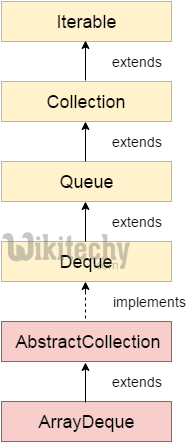java tutorial - Java Deque Interface - java programming - learn java - java basics - java for beginners
Java Deque Interface is a linear collection that supports element insertion and removal at both ends. Deque is an acronym for "double ended queue".
Deque Interface declaration
public interface Deque<E> extends Queue<E> click below button to copy the code. By - java tutorial - team
Methods of Java Deque Interface
| Method | Description |
|---|---|
| boolean add(object) | It is used to insert the specified element into this deque and return true upon success. |
| boolean offer(object) | It is used to insert the specified element into this deque. |
| Object remove() | It is used to retrieves and removes the head of this deque. |
| Object poll() | It is used to retrieves and removes the head of this deque, or returns null if this deque is empty. |
| Object element() | It is used to retrieves, but does not remove, the head of this deque. |
| Object peek() | It is used to retrieves, but does not remove, the head of this deque, or returns null if this deque is empty. |
ArrayDeque class
The ArrayDeque class provides the facility of using deque and resizable-array. It inherits AbstractCollection class and implements the Deque interface.
The important points about ArrayDeque class are:
- Unlike Queue, we can add or remove elements from both sides.
- Null elements are not allowed in the ArrayDeque.
- ArrayDeque is not thread safe, in the absence of external synchronization.
- ArrayDeque has no capacity restrictions.
- ArrayDeque is faster than LinkedList and Stack.
ArrayDeque Hierarchy
- The hierarchy of ArrayDeque class is given in the figure displayed at the right side of the page.

Learn java - java tutorial - array-deque - java examples - java programs
ArrayDeque class declaration
Let's see the declaration for java.util.ArrayDeque class.
public class ArrayDeque<E> extends AbstractCollection<E> implements Deque<E>, Cloneable, Serializable click below button to copy the code. By - java tutorial - team
Java ArrayDeque Example
import java.util.*;
public class ArrayDequeExample {
public static void main(String[] args) {
//Creating Deque and adding elements
Deque<String> deque = new ArrayDeque<String>();
deque.add("Ravi");
deque.add("Vijay");
deque.add("Ajay");
//Traversing elements
for (String str : deque) {
System.out.println(str);
}
}
} click below button to copy the code. By - java tutorial - team
Output:
Ravi
Vijay
AjayJava ArrayDeque Example: offerFirst() and pollLast()
import java.util.*;
public class DequeExample {
public static void main(String[] args) {
Deque<String> deque=new ArrayDeque<String>();
deque.offer("arvind");
deque.offer("vimal");
deque.add("mukul");
deque.offerFirst("jai");
System.out.println("After offerFirst Traversal...");
for(String s:deque){
System.out.println(s);
}
//deque.poll();
//deque.pollFirst();//it is same as poll()
deque.pollLast();
System.out.println("After pollLast() Traversal...");
for(String s:deque){
System.out.println(s);
}
}
} click below button to copy the code. By - java tutorial - team
Output:
After offerFirst Traversal...
jai
arvind
vimal
mukul
After pollLast() Traversal...
jai
arvind
vimalJava ArrayDeque Example: Book
import java.util.*;
public class Book {
int id;
String name,author,publisher;
int quantity;
public Book(int id, String name, String author, String publisher, int quantity) {
this.id = id;
this.name = name;
this.author = author;
this.publisher = publisher;
this.quantity = quantity;
}
}
public class ArrayDequeExample {
public static void main(String[] args) {
Deque<Book> set=new ArrayDeque<Book>();
//Creating Books
Book b1=new Book(101,"Let us C","Yashwant Kanetkar","BPB",8);
Book b2=new Book(102,"Data Communications & Networking","Forouzan","Mc Graw Hill",4);
Book b3=new Book(103,"Operating System","Galvin","Wiley",6);
//Adding Books to Deque
set.add(b1);
set.add(b2);
set.add(b3);
//Traversing ArrayDeque
for(Book b:set){
System.out.println(b.id+" "+b.name+" "+b.author+" "+b.publisher+" "+b.quantity);
}
}
} click below button to copy the code. By - java tutorial - team
Output:
101 Let us C Yashwant Kanetkar BPB 8
102 Data Communications & Networking Forouzan Mc Graw Hill 4
103 Operating System Galvin Wiley 6